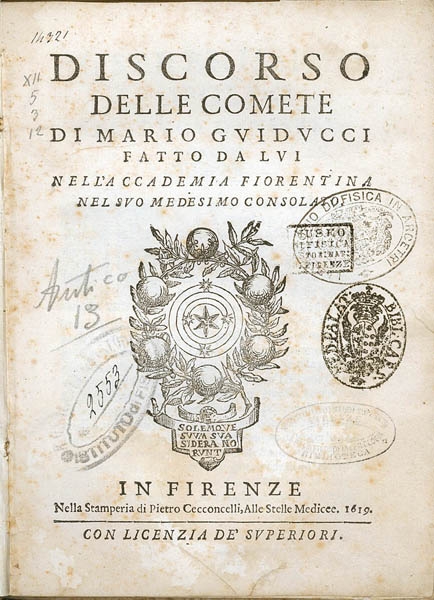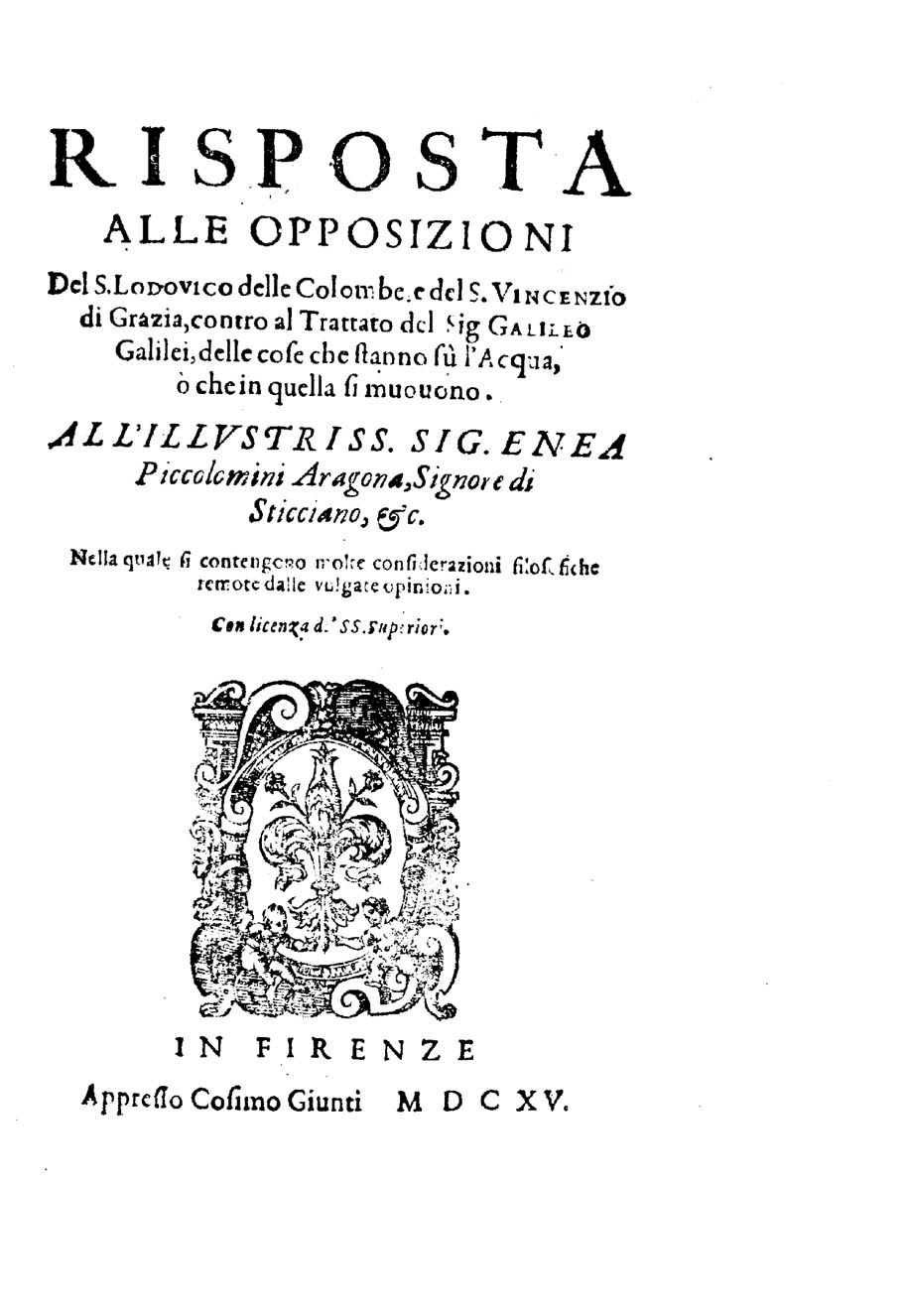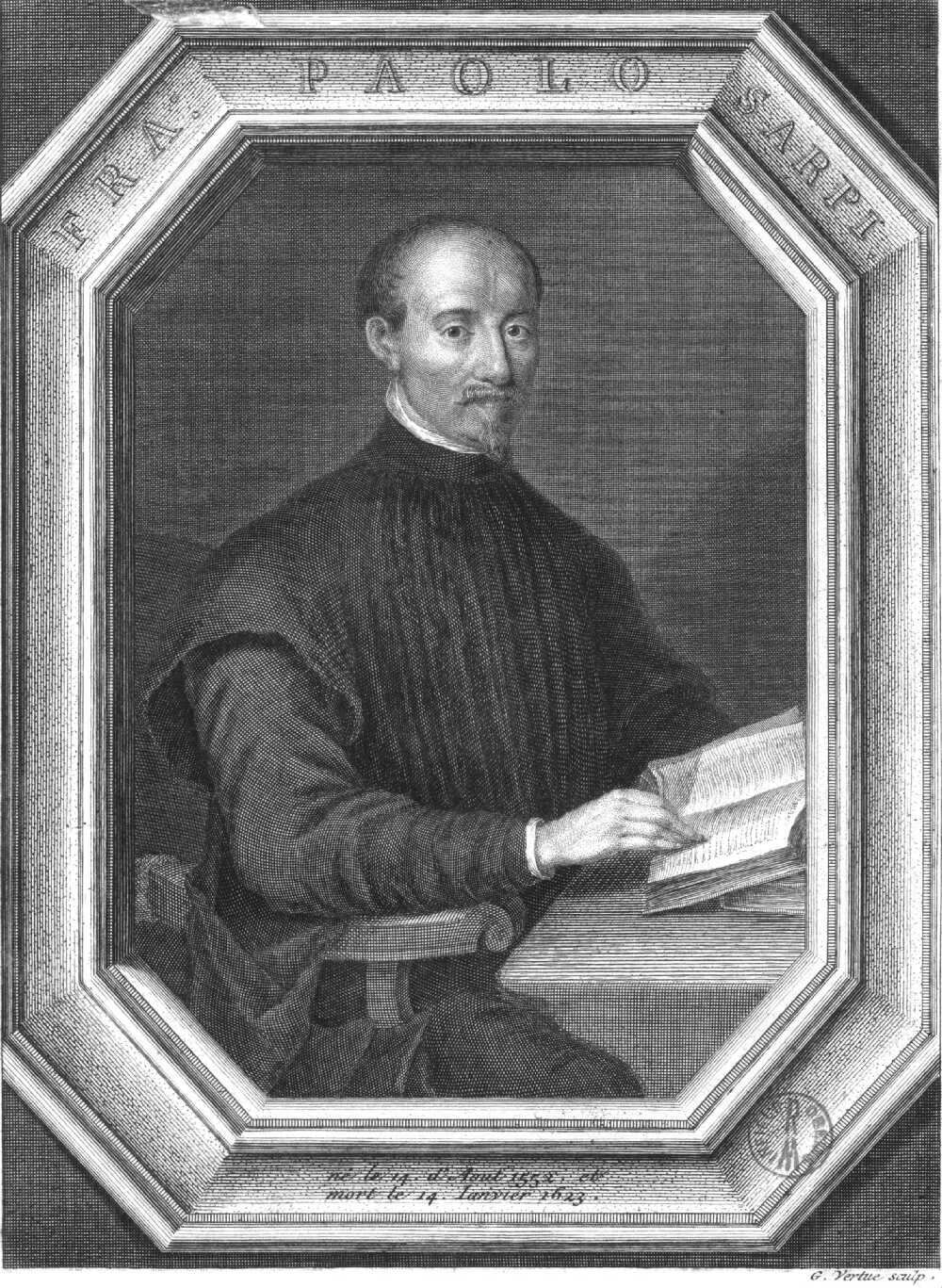|
Galileo
Galileo di Vincenzo Bonaiuti de' Galilei (15 February 1564 – 8 January 1642) was an Italian astronomer, physicist and engineer, sometimes described as a polymath. Commonly referred to as Galileo, his name was pronounced (, ). He was born in the city of Pisa, then part of the Duchy of Florence. Galileo has been called the "father" of observational astronomy, modern physics, the scientific method, and modern science. Galileo studied speed and velocity, gravity and free fall, the principle of relativity, inertia, projectile motion and also worked in applied science and technology, describing the properties of pendulums and " hydrostatic balances". He invented the thermoscope and various military compasses, and used the telescope for scientific observations of celestial objects. His contributions to observational astronomy include telescopic confirmation of the phases of Venus, observation of the four largest satellites of Jupiter, observation of Saturn's ring ... [...More Info...] [...Related Items...] OR: [Wikipedia] [Google] [Baidu] |
Galileo Galilei Signature 2
Galileo di Vincenzo Bonaiuti de' Galilei (15 February 1564 – 8 January 1642) was an Italian astronomer, physicist and engineer, sometimes described as a polymath. Commonly referred to as Galileo, his name was pronounced (, ). He was born in the city of Pisa, then part of the Duchy of Florence. Galileo has been called the "father" of observational astronomy, modern physics, the scientific method, and modern science. Galileo studied speed and velocity, gravity and free fall, the principle of relativity, inertia, projectile motion and also worked in applied science and technology, describing the properties of pendulums and " hydrostatic balances". He invented the thermoscope and various military compasses, and used the telescope for scientific observations of celestial objects. His contributions to observational astronomy include telescopic confirmation of the phases of Venus, observation of the four largest satellites of Jupiter, observation of Saturn's rings, and ... [...More Info...] [...Related Items...] OR: [Wikipedia] [Google] [Baidu] |
Mario Guiducci
Mario Guiducci (Florence 18 March 1583 - Florence 5 November 1646) was an Italian scholar and writer. A friend and colleague of Galileo, he collaborated with him on the '' Discourse on Comets'' in 1618. Early life Mario Guiducci was born in the San Frediano quarter of Florence. His father was Alessandro Guiducci, son of a senator, and his mother was Camilla Capponi. He had at least two brothers, Giulio, who died in 1654 and Simone, as well as a sister, Maddalena, who married Orazio Cavalcanti. He was sent to the Jesuit College in Rome as a boy. He never appears to have earned his doctorate in philosophy at Rome, but he did become a Doctor of both laws at the university of Pisa on 27 May 1610. At some time, probably after this, he became a pupil either of Benedetto Castelli, or, possibly, of Galileo himself. Disputes about comets, 1618-20 In 1618, the year Guiducci became consul of the Accademia Fiorentina, a particularly bright and long-lasting comet was seen in the skies over ... [...More Info...] [...Related Items...] OR: [Wikipedia] [Google] [Baidu] |
Heliocentrism
Heliocentrism (also known as the Heliocentric model) is the astronomical model in which the Earth and planets revolve around the Sun at the center of the universe. Historically, heliocentrism was opposed to geocentrism, which placed the Earth at the center. The notion that the Earth revolves around the Sun had been proposed as early as the third century BC by Aristarchus of Samos, who had been influenced by a concept presented by Philolaus of Croton (c. 470 – 385 BC). In the 5th century BC the Greek Philosophers Philolaus and Hicetas had the thought on different occasions that our Earth was spherical and revolving around a "mystical" central fire, and that this fire regulated the universe. In medieval Europe, however, Aristarchus' heliocentrism attracted little attention—possibly because of the loss of scientific works of the Hellenistic period. It was not until the sixteenth century that a mathematical model of a heliocentric system was presented by the Renaissance mat ... [...More Info...] [...Related Items...] OR: [Wikipedia] [Google] [Baidu] |
Vincenzo Viviani
Vincenzo Viviani (April 5, 1622 – September 22, 1703) was an Italian mathematician and scientist. He was a pupil of Torricelli and a disciple of Galileo."Viviani" article in the Biography Vincenzo Viviani was born in Florence to the nobles Jacopo di Michelangelo Viviani and Maria Alamanno del Nente. While attending a Jesuit school Viviani studied the humanities. Following the study of humanities, Viviani turned to mathematics. He studied[...More Info...] [...Related Items...] OR: [Wikipedia] [Google] [Baidu] |
Nicolaus Copernicus
Nicolaus Copernicus (; pl, Mikołaj Kopernik; gml, Niklas Koppernigk, german: Nikolaus Kopernikus; 19 February 1473 – 24 May 1543) was a Renaissance polymath, active as a mathematician, astronomer, and Catholic canon, who formulated a model of the universe that placed the Sun rather than Earth at its center. In all likelihood, Copernicus developed his model independently of Aristarchus of Samos, an ancient Greek astronomer who had formulated such a model some eighteen centuries earlier. The publication of Copernicus's model in his book ' (''On the Revolutions of the Celestial Spheres''), just before his death in 1543, was a major event in the history of science, triggering the Copernican Revolution and making a pioneering contribution to the Scientific Revolution. Copernicus was born and died in Royal Prussia, a region that had been part of the Kingdom of Poland since 1466. A polyglot and polymath, he obtained a doctorate in canon law and was a mathematic ... [...More Info...] [...Related Items...] OR: [Wikipedia] [Google] [Baidu] |
Benedetto Castelli
Benedetto Castelli (1578 – 9 April 1643), born Antonio Castelli, was an Italian mathematician. Benedetto was his name in religion on entering the Benedictine Order in 1595. Life Born in Brescia, Castelli studied at the University of Padua and later became an abbot at the Benedictine monastery in Monte Cassino. He was a long-time friend and supporter of his teacher, Galileo Galilei, and in turn teacher to Galileo's son. He assisted Galileo's study of sunspots and participated in the examination of the theories of Nicolaus Copernicus. Castelli was interested in mathematics and hydraulics. He was appointed as a mathematician to the University of Pisa, replacing Galileo, and later at the University of Rome La Sapienza. Castelli introduced Bonaventura Cavalieri to Galileo, leading to an extensive correspondence between the latter; Galileo was instrumental in procuring a position for Cavalieri at the University of Bologna in 1629. Castelli was involved in the discovery of the ... [...More Info...] [...Related Items...] OR: [Wikipedia] [Google] [Baidu] |
Cosimo II De Medici
Cosimo II de' Medici (12 May 1590 – 28 February 1621) was Grand Duke of Tuscany from 1609 until his death. He was the elder son of Ferdinando I de' Medici, Grand Duke of Tuscany, and Christina of Lorraine. For the majority of his twelve-year reign, he delegated the administration of Tuscany to his ministers. He is best remembered as the patron of Galileo Galilei, his childhood tutor. Biography Cosimo's father Ferdinando I took care to provide him with a modern education. Indeed, Galileo Galilei was Cosimo's tutor between 1605 and 1608. Ferdinando arranged for him to marry Archduchess Maria Maddalena of Austria, daughter of Archduke Charles II, in 1608. Their marriage was celebrated with an elaborate display on the Arno, which included a performance of the ''Argonautica'', in which Jason sailed around an artificial island and presented Maria Maddalena with six red apples, alluding to the Medici family symbolic balls, or palle. Cosimo and Maria Maddalena had eight children ... [...More Info...] [...Related Items...] OR: [Wikipedia] [Google] [Baidu] |
Ostilio Ricci Da Fermo
Ostilio Ricci da Fermo (1540–1603) was an Italian mathematician. Biography He was a university professor in Florence at the Accademia delle Arti del Disegno, founded in 1560 by Giorgio Vasari. Ricci is also known for being Galileo Galilei's teacher. Ricci was the Court Mathematician to the Grand Duke Francesco in Florence, in 1580, when Galileo attended his lectures in Pisa. Galileo was enrolled at the University of Pisa, by his father Vincenzo, in order to study medicine. Instead, Galilei became more interested in mathematics, after meeting Ostilio Ricci, a former student of Niccolò Tartaglia. Ricci taught Galileo the mathematics of Euclid and Archimedes Archimedes of Syracuse (;; ) was a Greek mathematician, physicist, engineer, astronomer, and inventor from the ancient city of Syracuse in Sicily. Although few details of his life are known, he is regarded as one of the leading scientis ..., who both deeply influenced Galileo's later work. Ricci considered ma ... [...More Info...] [...Related Items...] OR: [Wikipedia] [Google] [Baidu] |
Justus Sustermans
Justus Sustermans, Joost Sustermans or Suttermans, his given name Italianised to Giusto (Antwerp, 28 September 1597 – Florence, 23 April 1681), was a Flemish painter and draughtsman who is mainly known for his portraits. He also painted history and genre paintings, still lifes and animals.Justus Sustermans at the Netherlands Institute for Art History Sustermans is chiefly noted for his portraits of members of the as he was its . Th ... [...More Info...] [...Related Items...] OR: [Wikipedia] [Google] [Baidu] |
Fra Paolo Sarpi
Paolo Sarpi (14 August 1552 – 15 January 1623) was a Venetian historian, prelate, scientist, canon lawyer, and statesman active on behalf of the Venetian Republic during the period of its successful defiance of the papal interdict (1605–1607) and its war (1615–1617) with Austria over the Uskok pirates. His writings, frankly polemical and highly critical of the Catholic Church and its Scholastic tradition, "inspired both Hobbes and Edward Gibbon in their own historical debunkings of priestcraft." Sarpi's major work, the ''History of the Council of Trent'' (1619), was published in London in 1619; other works: a ''History of Ecclesiastical Benefices'', ''History of the Interdict'' and his ''Supplement to the History of the Uskoks'', appeared posthumously. Organized around single topics, they are early examples of the genre of the historical monograph. As a defender of the liberties of Republican Venice and proponent of the separation of Church and state, Sarpi attained ... [...More Info...] [...Related Items...] OR: [Wikipedia] [Google] [Baidu] |
Physics
Physics is the natural science that studies matter, its fundamental constituents, its motion and behavior through space and time, and the related entities of energy and force. "Physical science is that department of knowledge which relates to the order of nature, or, in other words, to the regular succession of events." Physics is one of the most fundamental scientific disciplines, with its main goal being to understand how the universe behaves. "Physics is one of the most fundamental of the sciences. Scientists of all disciplines use the ideas of physics, including chemists who study the structure of molecules, paleontologists who try to reconstruct how dinosaurs walked, and climatologists who study how human activities affect the atmosphere and oceans. Physics is also the foundation of all engineering and technology. No engineer could design a flat-screen TV, an interplanetary spacecraft, or even a better mousetrap without first understanding the basic laws of phys ... [...More Info...] [...Related Items...] OR: [Wikipedia] [Google] [Baidu] |
Ferdinando II De Medici
Ferdinando II de' Medici (14 July 1610 – 23 May 1670) was grand duke of Tuscany from 1621 to 1670. He was the eldest son of Cosimo II de' Medici and Maria Maddalena of Austria. He was remembered by his contemporaries as a man of culture and science, actively participating in the Accademia del Cimento, the first scientific society in Italy, formed by his younger brother, Leopoldo de' Medici. His 49-year rule was punctuated by the beginning of Tuscany's long economic decline, which was further exacerbated by his successor, Cosimo III de' Medici. He married Vittoria della Rovere, a first cousin, with whom he had two children who reached adulthood: the aforementioned Cosimo III, and Francesco Maria de' Medici, Duke of Rovere and Montefeltro, a cardinal. Reign Ferdinando was only 10 years of age when his father Cosimo II died. Because he had not yet reached maturity, his mother Maria Maddalena and paternal grandmother, Christina of Lorraine, acted as joint regents. His two regen ... [...More Info...] [...Related Items...] OR: [Wikipedia] [Google] [Baidu] |





.jpg)
.jpg)

